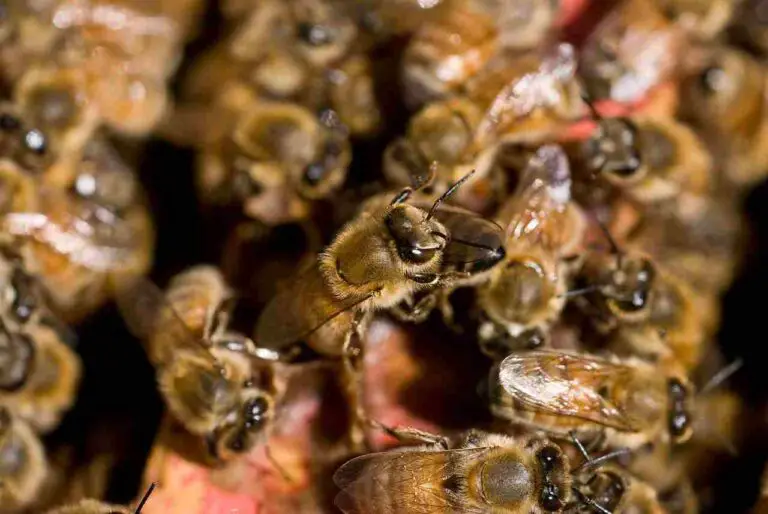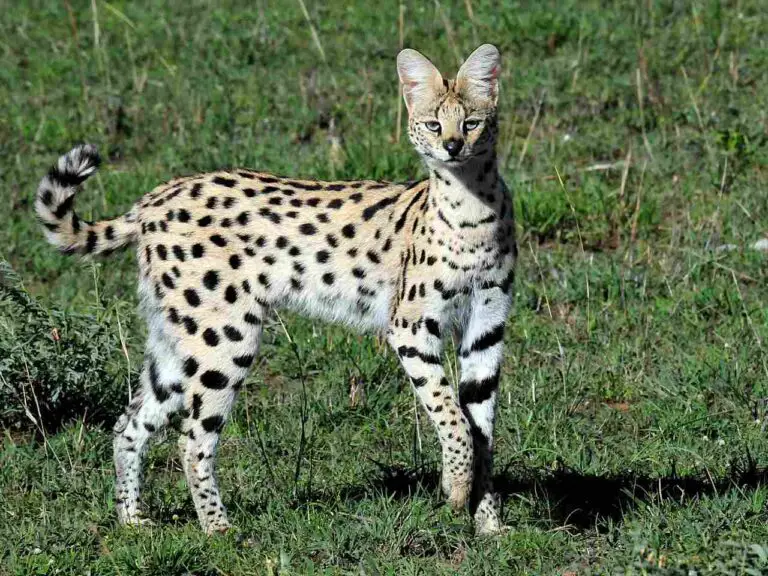Gila Monster Vs Mexican Beaded Lizard Size, Weight, Overall Comparison
Gila monsters and Mexican beaded lizards, both belonging to the Helodermatidae family, are venomous reptiles known for their distinctive characteristics. A Mexican beaded lizard would win a Gila monster in a fight mainly due to its size and weight advantage, combined with the fact that it also produces venom.
This analysis explores the differences between these two species, shedding light on their size, venomous properties, and real-life confrontation scenarios.
I. Size and Length:
– Adult Mexican beaded lizards are substantially larger, ranging from 57 to 91 cm (22 to 36 in) in length, compared to Gila monsters, which reach lengths of 30 to 56 cm (12 to 22 in). The beaded lizard’s larger size provides a potential advantage in confrontations.
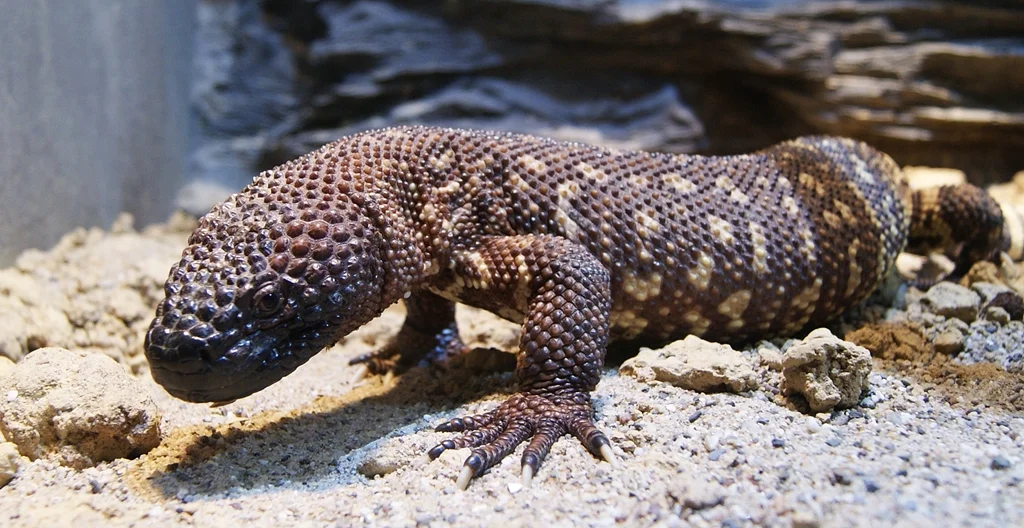
II. Venomous Properties:
– Both Gila monsters and Mexican beaded lizards are venomous, possessing venom glands. Scientific studies, such as those on PubMed, indicate that their venoms enhance guanylate cyclase activity. This venomous nature is a commonality, making their real-life confrontations particularly formidable.
III. Geographic Distribution:
– Gila monsters are found in the southwestern United States, while Mexican beaded lizards inhabit regions in Mexico. Their separate distributions may influence their encounters, considering varied habitats and environmental conditions.
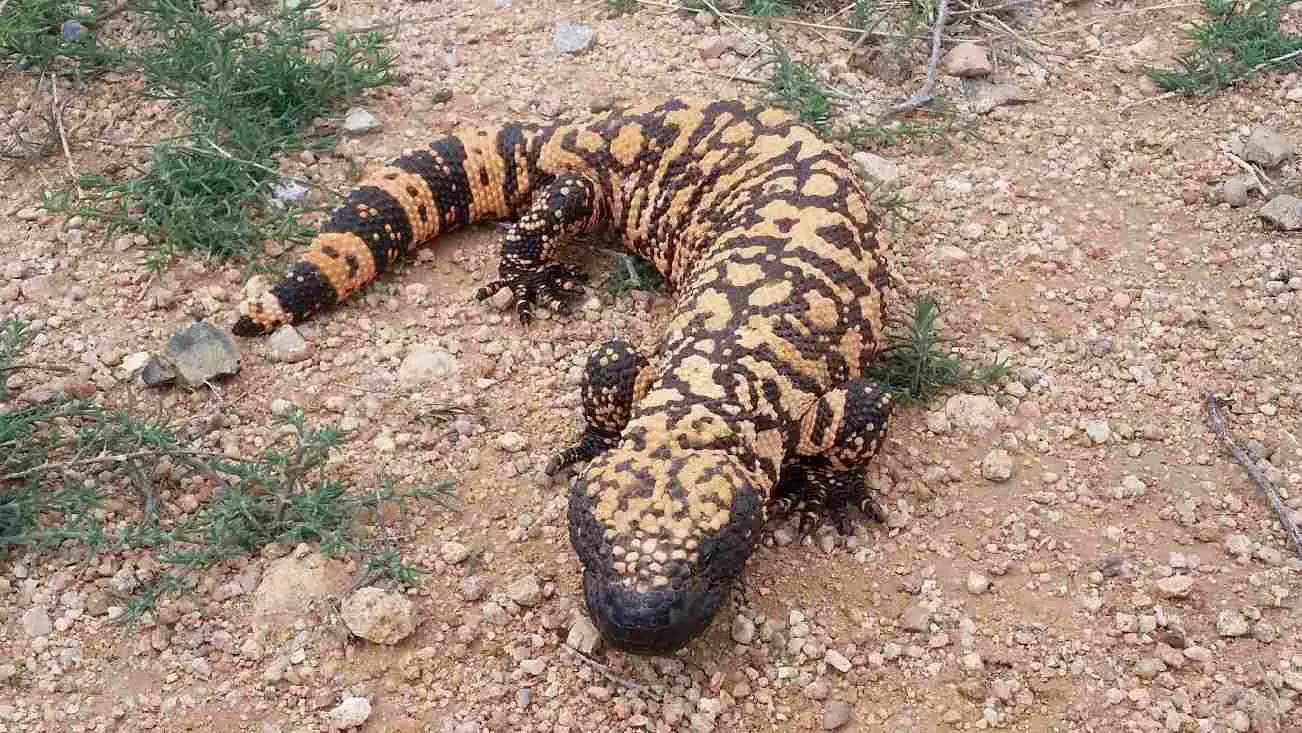
*Details of Comparison
| Criteria | Gila Monster |
Mexican Beaded Lizard
|
| Appearance | Vibrant black and pinkish-orange bead-like scales |
Similar bead-like scales, often darker
|
| Size | 18-24 inches | 20-36 inches |
| Weight | 1-2 pounds | 2-4 pounds |
| Bite Force (PSI) | Moderate bite force |
Stronger bite force
|
| Physical Offensive Advantages | Venomous bites with grooved teeth |
Similar venomous bite capability
|
| Physical Defensive Advantages | Stout build, tough, beaded scales |
Robust body structure, thick, bony scales
|
| Speed | Slow movement (1-2 mph) | Slow movement |
| Agility | Low agility | Moderate agility |
| Senses | Acute sense of smell, good vision |
Well-developed sense of smell, vision
|
| Overall Physical Capacity | Adapted to arid environments, efficient thermoregulation |
Robust physical build suitable for diverse habitats
|
| Habitat Preference and Geographic Region | Arid regions in southwestern U.S. and Mexico |
Deserts, tropical dry forests in Mexico
|
| Tracks | Short, wide tracks |
Similar tracks, potentially larger
|
| Lifespan | 20-25 years | 25-35 years |
| Mode of Feeding | Carnivorous, preys on small mammals, eggs |
Carnivorous, includes small mammals, eggs
|
| Intelligence | Limited cognitive abilities |
Limited cognitive abilities
|
| Social Behavior | Generally solitary, aggressive during mating |
Primarily solitary, territorial during mating
|
| Mode of Reproduction | Oviparous, lays eggs in burrows |
Oviparous, lays eggs in soil or sheltered locations
|
| Parental Behavior | Limited parental care, female guards nest |
Limited parental care, female protects nest, may stay with offspring briefly
|
| Proximity to Human-Inhabited Areas | Can be found in suburban areas |
May inhabit areas close to human settlements
|
| Behavior Toward Humans | Generally shy, may bite if provoked |
Tends to avoid humans, may bite if threatened
|
| Danger Posed to Humans | Venomous bite, rarely fatal but painful |
Venomous bite, effects similar to Gila Monster, bites uncommon
|
| Associated Precautions | Caution advised, avoid provoking or handling |
Similar precautions, avoidance and respect recommended
|
| Conservation Status | Near Threatened, faces habitat loss and illegal pet trade threats |
Near Threatened, threats include habitat loss, pet trade, and traditional medicine
|
Key Points
- Both species share bead-like scale patterns but differ in coloration.
- Mexican Beaded Lizard is generally larger and heavier.
- Mexican Beaded Lizard has a stronger bite force.
- Both exhibit venomous bites for offense and have physical defenses.
- Both species move slowly and lack high agility.
- Both rely on acute senses for survival.
- Gila Monster is found in the southwestern U.S., while the Mexican Beaded Lizard is mainly in Mexico.
- Both have similar lifespans, feeding modes, and limited intelligence.
- Both are predominantly solitary with limited parental care.
- Gila Monster may tolerate human proximity more than the Mexican Beaded Lizard.
- Both species pose a potential danger to humans through their venomous bites.
- Conservation status for both is Near Threatened due to various threats.
- Overall, they share similarities in ecological roles but differ in specific adaptations and characteristics.
1. Taxonomy:
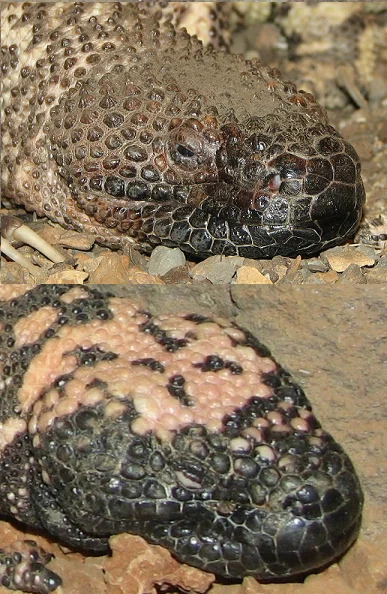
Gila Monster (Heloderma suspectum):
Class: Reptilia
Order: Squamata
Family: Helodermatidae
Genus: Heloderma
Species: H. suspectum
Mexican Beaded Lizard (Heloderma horridum):
Class: Reptilia
Order: Squamata
Family: Helodermatidae
Genus: Heloderma
Species: H. horridum
2. Appearance:
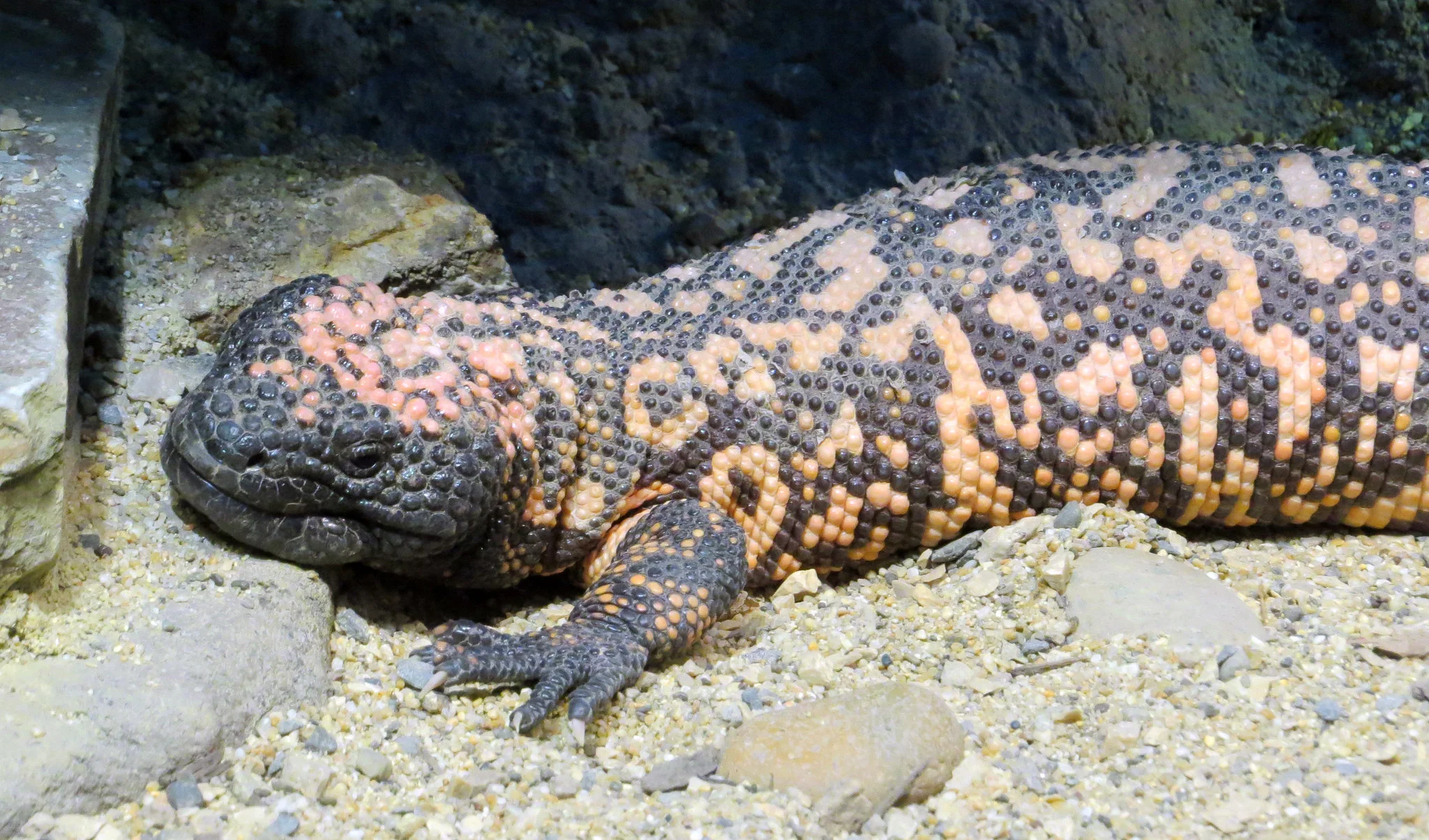
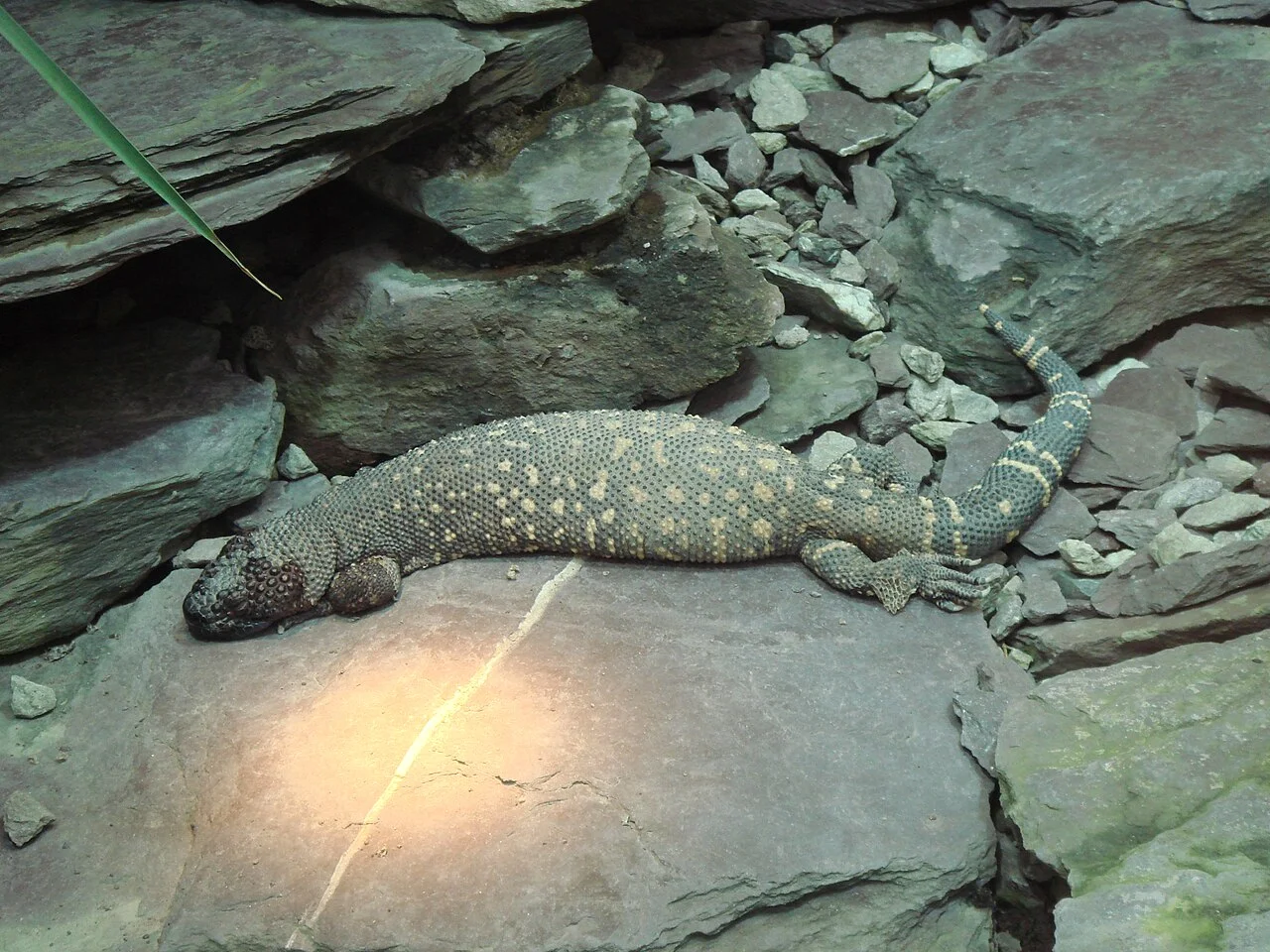
Gila Monster (Heloderma suspectum):
Distinguished by black and pinkish-orange bead-like scales in a distinctive pattern.
Stout body with a blunt tail.
Prominent, venomous, grooved teeth.
Mexican Beaded Lizard (Heloderma horridum):
Similar bead-like scales but often darker in color.
Robust build, similar to the Gila Monster.
Possesses venomous glands and strong jaws.
Comparison:
Both display bead-like scale patterns for camouflage.
Gila Monster tends to have a more vibrant coloration.
Ecological Implications:
Camouflage aids in avoiding predators and ambushing prey.
The coloration may play a role in thermoregulation.
3. Size:
Gila Monster:
Typically reaches lengths of 18 to 24 inches.
Mexican Beaded Lizard:
Generally larger, ranging from 20 to 36 inches.
Comparison:
Mexican Beaded Lizard is, on average, larger than the Gila Monster.
Ecological Implications:
Size influences prey selection and potential predators.
4. Weight:
Gila Monster:
Usually weighs between 1 to 2 pounds.
Mexican Beaded Lizard:
Heavier, often ranging from 2 to 4 pounds.
Comparison:
Mexican Beaded Lizard is generally heavier.
Ecological Implications:
Weight affects energy requirements and hunting strategies.
5. Bite Force (PSI – Pounds per Square Inch):
Gila Monster:
Moderate bite force.
Mexican Beaded Lizard:
Stronger bite force compared to the Gila Monster.
Comparison:
Mexican Beaded Lizard possesses a more powerful bite.
Ecological Implications:
Bite force influences prey subjugation and feeding habits.
6. Physical Offensive Advantages:
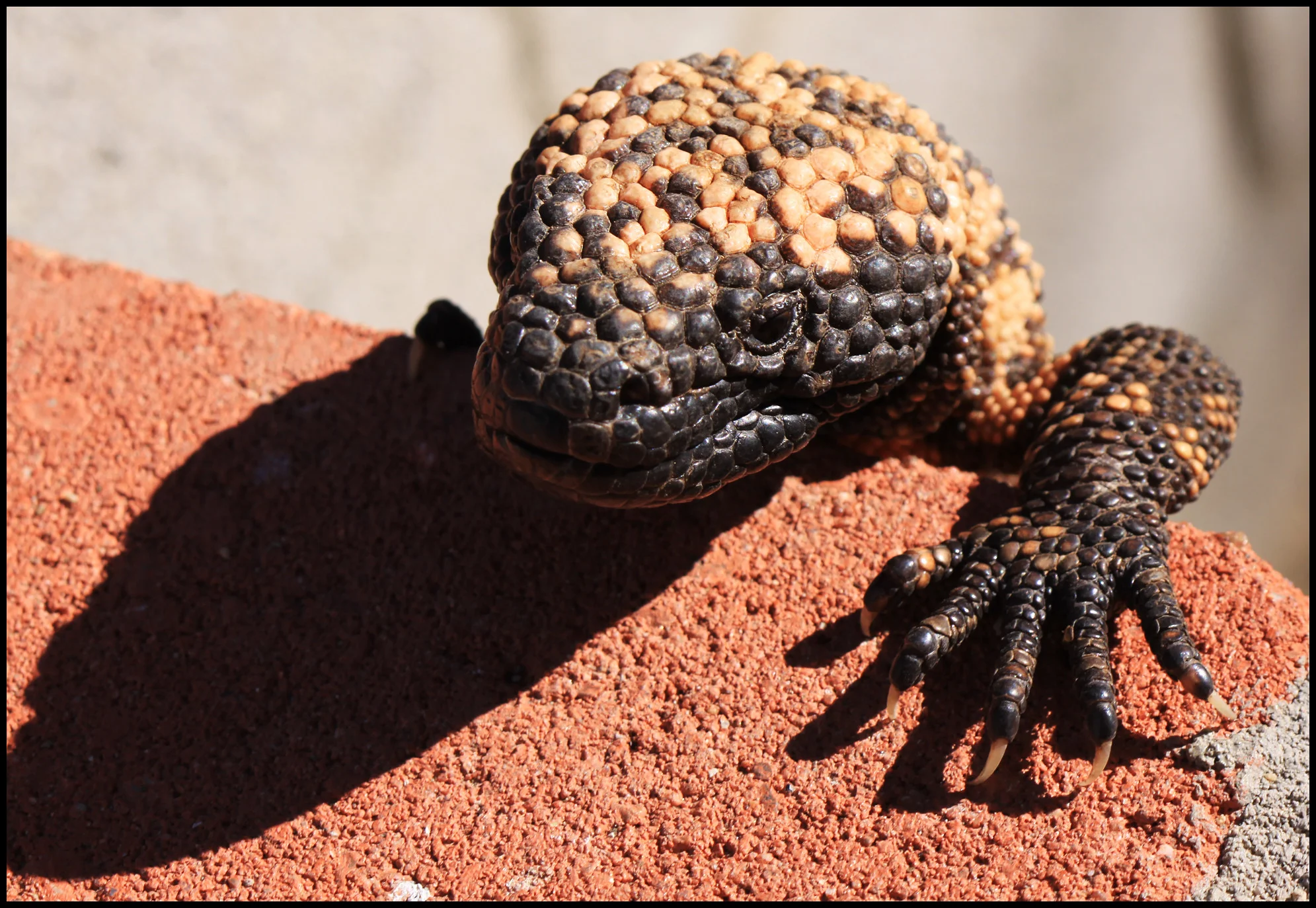
Gila Monster:
Venomous bite with grooved teeth for delivering venom.
Mexican Beaded Lizard:
Similar venomous bite capability with grooved teeth.
Comparison:
Both possess venomous bites as a primary offensive tool.
Ecological Implications:
Venom aids in subduing prey and acts as a deterrent against predators.
7. Physical Defensive Advantages:
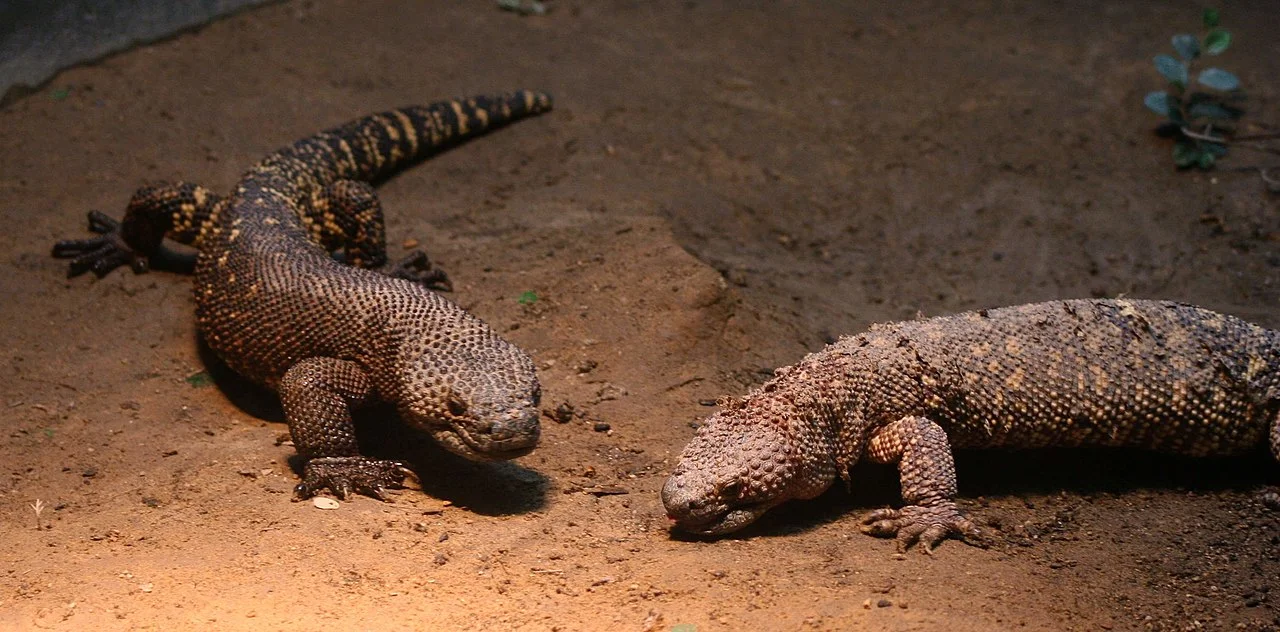
Gila Monster:
Stout build and tough, beaded scales offer protection.
Mexican Beaded Lizard:
Robust body structure with thick, bony scales for defense.
Comparison:
Both have physical adaptations for defense against predators.
Ecological Implications:
Defense mechanisms enhance survival in natural habitats.
8. Speed (Km/hour or Mile/hour):
Gila Monster:
Slow-moving, with a maximum speed of around 1-2 mph.
Mexican Beaded Lizard:
Generally slow-moving, with a similar maximum speed.
Comparison:
Both species exhibit slow locomotion.
Ecological Implications:
Slower speed is compensated by ambush predation strategies.
9. Agility:
Gila Monster:
Relatively low agility due to its stout build.
Mexican Beaded Lizard:
Moderate agility but limited compared to more agile species.
Comparison:
Neither species is highly agile.
Ecological Implications:
Limited agility is balanced by other adaptive features for survival.
10. Senses:
Gila Monster:
Acute sense of smell; detects chemical cues.
Good vision for both day and low-light conditions.
Mexican Beaded Lizard:
Well-developed sense of smell and vision.
Comparison:
Both rely on keen senses for navigation and hunting.
Ecological Implications:
Enhanced senses aid in locating prey and avoiding predators.
11. Overall Physical Capacity:
Gila Monster:
Adaptable to arid environments; efficient thermoregulation.
Mexican Beaded Lizard:
Robust physical build suitable for diverse habitats.
Comparison:
Both exhibit physical features adapted to their respective habitats.
Ecological Implications:
Physical capacities contribute to overall ecological niche occupancy.
12. Habitat Preference(s) and Geographic Region:
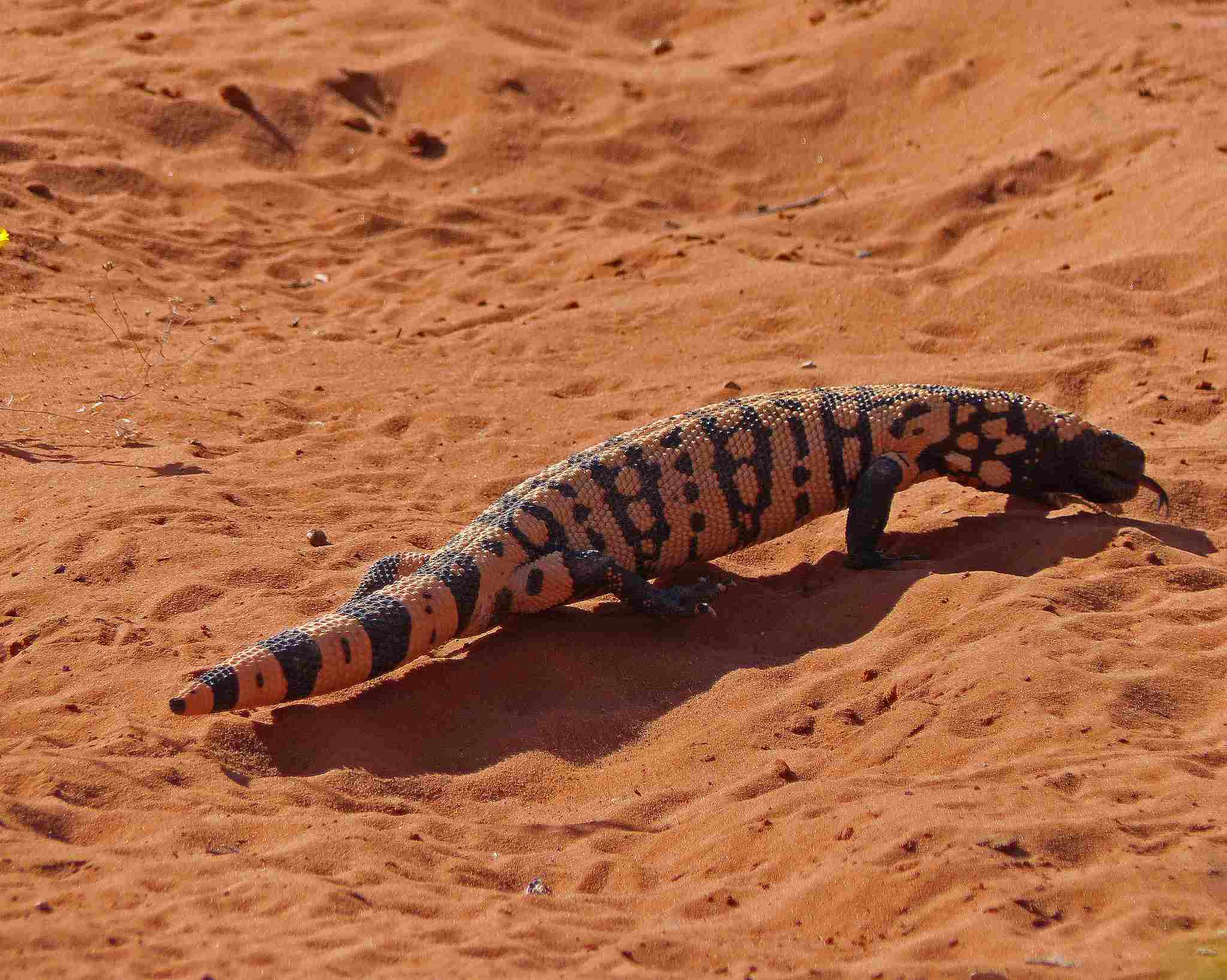
Gila Monster:
Prefers arid regions, deserts of the southwestern United States and Mexico.
Mexican Beaded Lizard:
Inhabits diverse environments including deserts and tropical dry forests in Mexico.
Comparison:
Overlapping habitats in some regions, but Gila Monster extends into the United States.
Ecological Implications:
Habitat preferences affect interactions with other species and resource availability.
13. Tracks:
Gila Monster:
Characterized by distinctive, short, and wide tracks.
Mexican Beaded Lizard:
Similar tracks but potentially larger due to its larger size.
Comparison:
Track characteristics may vary slightly based on size.
Ecological Implications:
Tracking provides insights into their movement patterns and behavior in the wild.
14. Lifespan:
Gila Monster:
Typically lives 20-25 years in the wild.
Mexican Beaded Lizard:
Generally has a longer lifespan, around 25-35 years.
Comparison:
Mexican Beaded Lizard tends to have a slightly longer lifespan.
Ecological Implications:
Longer lifespan contributes to population dynamics and ecological roles.
15. Mode of Feeding:
Gila Monster:
Carnivorous; preys on small mammals, birds, and eggs.
Mexican Beaded Lizard:
Carnivorous diet, includes small mammals and eggs.
Comparison:
Both species share a similar carnivorous feeding mode.
Ecological Implications:
Predatory roles impact prey populations and ecosystem balance.
16. Intelligence:
Gila Monster:
Limited cognitive abilities.
Mexican Beaded Lizard:
Limited cognitive abilities, similar to the Gila Monster.
Comparison:
Both species exhibit basic reptilian intelligence.
Ecological Implications:
Intelligence influences problem-solving and survival strategies.
17. Social Behavior:
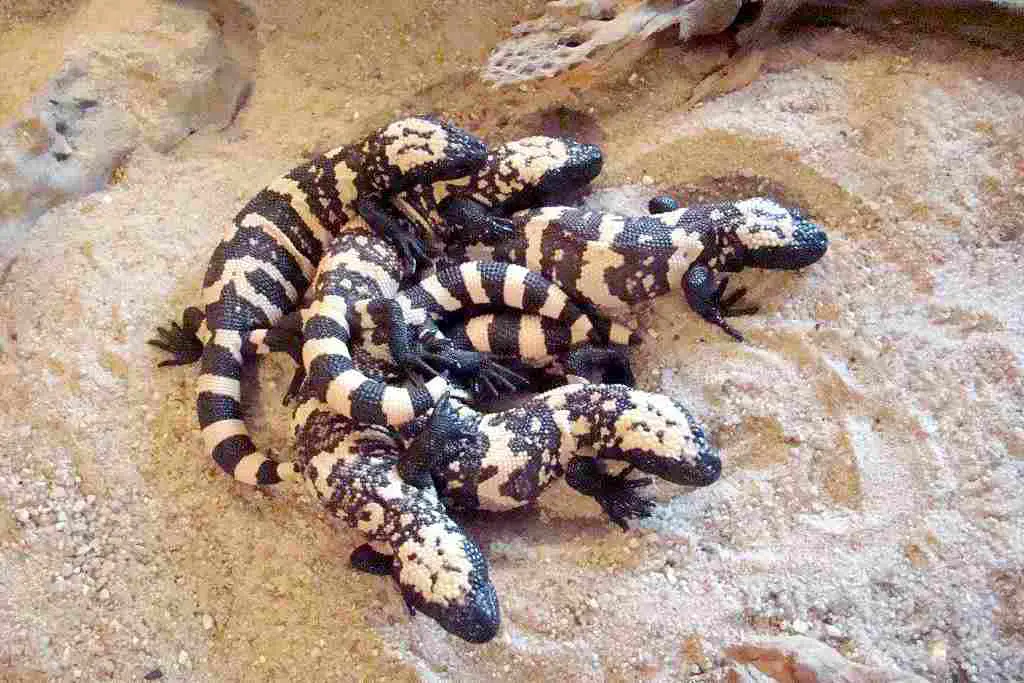
Gila Monster:
Generally solitary; may exhibit aggression during mating season.
Mexican Beaded Lizard:
Primarily solitary, territorial during mating.
Comparison:
Both species are predominantly solitary.
Ecological Implications:
Solitary behavior reduces competition for resources within their habitats.
18. Mode of Reproduction:
Gila Monster:
Oviparous; females lay eggs in burrows.
Mexican Beaded Lizard:
Oviparous; lays eggs in soil or sheltered locations.
Comparison:
Both species reproduce through egg-laying.
Ecological Implications:
Reproductive strategies influence population dynamics.
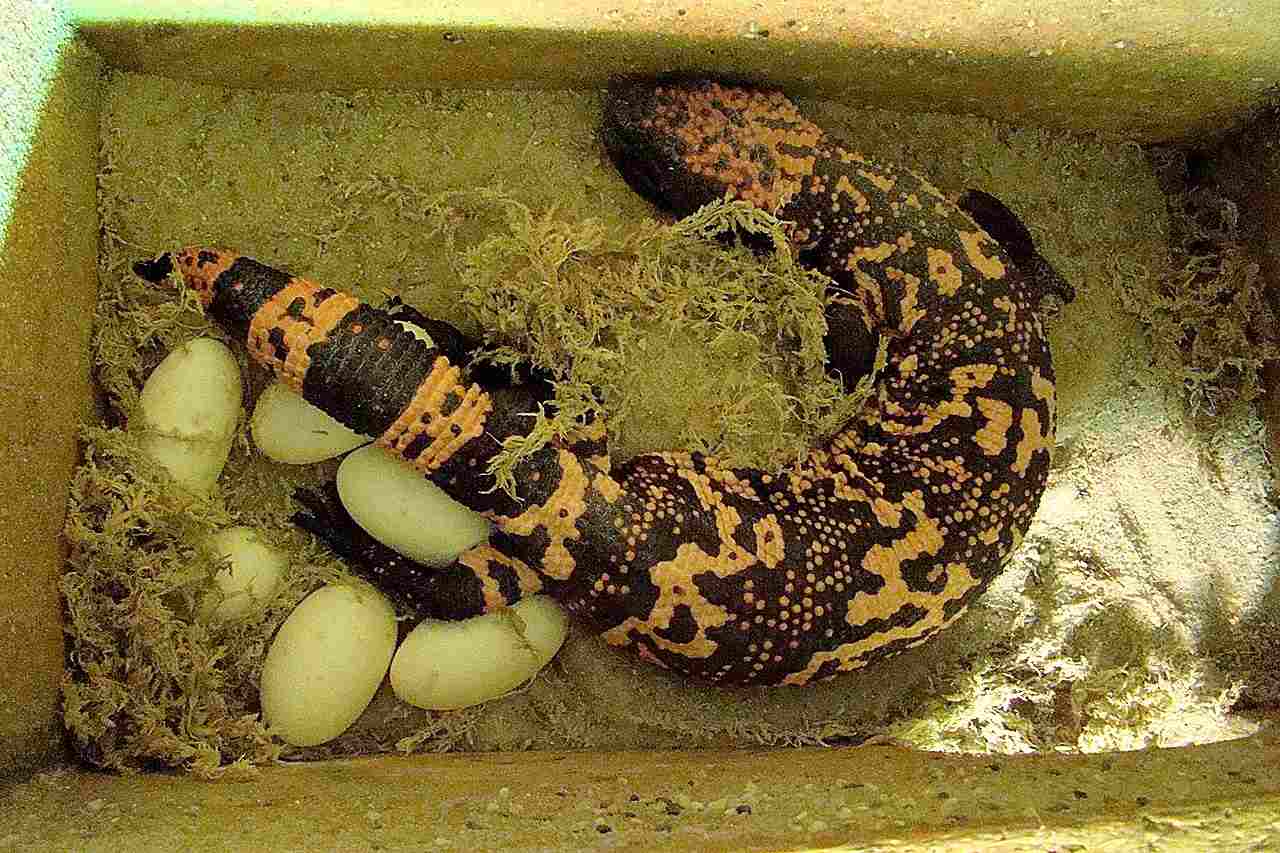
19. Parental Behavior:
Gila Monster:
Limited parental care; female guards the nest.
Mexican Beaded Lizard:
Limited parental care; female protects the nest and may stay with the offspring for a short period.
Comparison:
Both exhibit minimal parental care.
Ecological Implications:
Parental behavior impacts offspring survival rates.
20. Proximity to Human-Inhabited Areas:
Gila Monster:
Can be found in proximity to human settlements, especially in suburban areas.
Mexican Beaded Lizard:
May inhabit areas close to human settlements, but typically in less populated regions.
Comparison:
Gila Monster shows a higher tolerance for human proximity.
Ecological Implications:
Human-encroached habitats pose challenges and opportunities for adaptation.
21. Behavior Toward Humans:
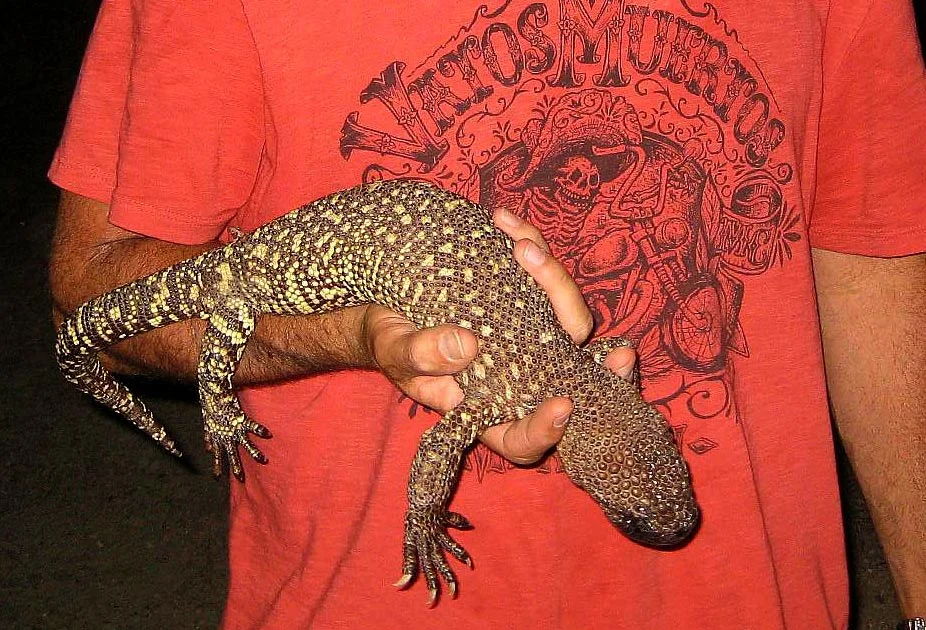
Gila Monster:
Generally shy and avoids confrontations; may bite if provoked.
Mexican Beaded Lizard:
Similar behavior, avoiding humans but may bite if threatened.
Comparison:
Both species tend to avoid human interaction.
Ecological Implications:
Behaviors contribute to human-wildlife interactions and potential conflicts.
22. Danger Posed to Humans:
Gila Monster:
Venomous bite, though rarely fatal to humans; bites are painful and may cause nausea.
Mexican Beaded Lizard:
Venomous bite, with effects similar to the Gila Monster; bites are uncommon.
Comparison:
Both pose a potential danger due to venomous bites.
Ecological Implications:
Human encounters may lead to negative perceptions and potential harm to the species.
23. Associated Precautions:
Gila Monster:
Caution advised; avoid provoking or handling.
Mexican Beaded Lizard:
Similar precautions; avoidance and respect recommended.
Comparison:
Both species require careful handling precautions.
Ecological Implications:
Awareness of these precautions supports coexistence and conservation efforts.
24. Conservation Status:
Gila Monster:
Near Threatened; faces habitat loss and illegal pet trade threats.
Mexican Beaded Lizard:
Near Threatened; habitat loss, collection for the pet trade, and traditional medicine pose risks.
Comparison:
Both species share a vulnerable conservation status.
Ecological Implications:
Conservation efforts are crucial for maintaining biodiversity and ecosystem balance.
*Summary of Comparison
Appearance:
Gila Monster has vibrant black and pinkish-orange bead-like scales.
Mexican Beaded Lizard has similar bead-like scales, often darker.
Size:
Gila Monster is generally 18-24 inches.
Mexican Beaded Lizard is larger, ranging from 20-36 inches.
Weight:
Gila Monster weighs 1-2 pounds.
Mexican Beaded Lizard is heavier, typically 2-4 pounds.
Bite Force (PSI):
Gila Monster has a moderate bite force.
Mexican Beaded Lizard has a stronger bite force.
Physical Offensive Advantages:
Both have venomous bites with grooved teeth.
Physical Defensive Advantages:
Gila Monster has stout build and tough, beaded scales.
Mexican Beaded Lizard has a robust body structure with thick, bony scales.
Speed:
Both exhibit slow movement, around 1-2 mph.
Agility:
Neither species is highly agile.
Senses:
Both rely on acute sense of smell and good vision.
Overall Physical Capacity:
Both have physical features adapted to their respective habitats.
Habitat Preference(s) and Geographic Region:
Gila Monster prefers arid regions in the southwestern United States and Mexico.
Mexican Beaded Lizard inhabits diverse environments including deserts and tropical dry forests in Mexico.
Tracks:
Both leave distinctive, short, and wide tracks.
Lifespan:
Gila Monster typically lives 20-25 years.
Mexican Beaded Lizard generally has a longer lifespan, around 25-35 years.
Mode of Feeding:
Both are carnivorous, preying on small mammals and eggs.
Intelligence:
Both exhibit limited reptilian intelligence.
Social Behavior:
Both are predominantly solitary.
Mode of Reproduction:
Both are oviparous, laying eggs.
Parental Behavior:
Both exhibit minimal parental care.
Proximity to Human-Inhabited Areas:
Gila Monster can be found in suburban areas.
Mexican Beaded Lizard typically inhabits less populated regions.
Behavior Toward Humans:
Both tend to avoid human interaction.
Danger Posed to Humans:
Both have a venomous bite, rarely fatal but painful.
Associated Precautions:
Caution is advised for both species.
Conservation Status:
Both are Near Threatened due to habitat loss and illegal trade.
Conclusion
I). Similarities:
Both belong to the Helodermatidae family.
Similarities in ecology, behavior, and conservation status.
II). Differences:
Varied coloration and size.
Differences in venom potency and potential impact on humans.


